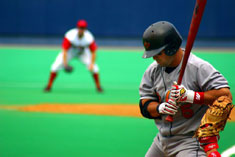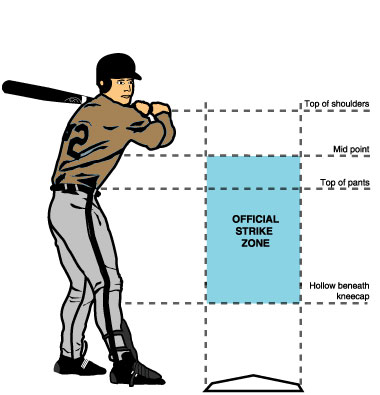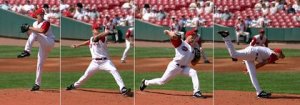
Simple rules about Pitching and the strike zone
 |
The battle between the teams involves constant skirmishes between their respective pitchers and their opponent's batters. The pitcher has incentives to pitch the baseball to an area, the strike zone, where it is relatively easy for the batter to strike it with his bat. In other words, the pitcher does not want to throw the ball where it is relatively easy for the batter to hit it, but, on the other hand he runs the risk of being penalized if he doesn't throw the ball into the strike zone. We'll explain the penalties in the sections about batting.
 |
| Strike Zone Graphic by MLB We are amazed that they don't draw the "midpoint" line exactly halfway between the top of shoulders and top of pants. But, hey, it was free. |
The strike zone is an imaginary box above home plate, and the umpire judges whether or not a baseball has entered it. His judgement can cause controversy.
The dimensions of the strike zone vary according to the batter's height and stance. The 2004 Official Rules of Major League Baseball defines it as "that area over home plate the upper limit of which is a horizontal line at the midpoint between the top of the shoulders and the top of the uniform pants (of the batter), and the lower level is a line at the hollow beneath the knee cap." Needless to say, his judgment can arouse controversy.
 |
| The baseball pitcher throws overhand. (Softball rules call for underhand pitching.) |
Needing to deliver the baseball where he does not want to, the pitcher uses all his skill and cunning to try to prevent the batter from hitting it.
A skillful player can throw it in ways that make it go straight, or suddenly drop, or slide from one side to the other, or curve downwards.
It's as hard as a rock, so batters fear them when pitchers throw them close (by mistake or otherwise).
 Because
ground-in dirt or grass can affect their flight and visibility, baseballs
are replaced with great frequency.
Because
ground-in dirt or grass can affect their flight and visibility, baseballs
are replaced with great frequency.



